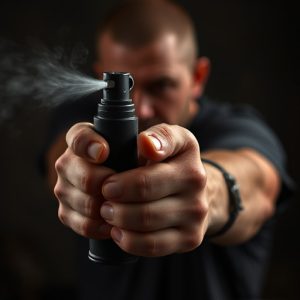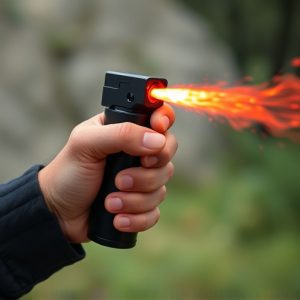Mastering Bear Spray: Best Application Techniques for Personal Security
Using non-lethal deterrents like bear spray effectively requires understanding optimal application t…….
Using non-lethal deterrents like bear spray effectively requires understanding optimal application techniques. Aim for sensitive areas like eyes and face from close range, practice deep breathing for control, consider wind conditions, and engage in regular training to ensure split-second decision-making during real-life encounters. Select a secure holster, regularly inspect the spray for expiration dates and nozzle integrity, and maintain proper distance and confidence when using bear spray as a last resort against aggressive animals.
“Personal security is a top priority in today’s diverse world. One innovative solution gaining traction as a non-lethal deterrent is bear spray—a powerful tool for self-defense against unexpected threats. This comprehensive guide explores the effectiveness of bear spray, offering an in-depth look at its benefits and practical usage.
From understanding the principles of non-lethal deterrents to mastering the best application techniques, this article equips readers with valuable insights. We’ll navigate real-world scenarios, ensuring you’re prepared to handle potential risks. Discover the key to maximizing protection and learn why bear spray is a game-changer for personal safety.”
- Understanding Non-Lethal Deterrents: A Comprehensive Overview
- Bear Spray: The Ultimate Non-Lethal Self-Defense Tool
- Best Practices for Choosing and Carrying Your Bear Spray
- Effective Application Techniques: Maximizing Protection
- Real-World Scenarios: When and How to Use Bear Spray
Understanding Non-Lethal Deterrents: A Comprehensive Overview
Non-lethal deterrents, also known as less-lethal weapons or tools, are designed to incapacitate or dissuade an attacker without causing permanent harm or death. These devices have gained significant attention in personal security and law enforcement circles due to their ability to balance protection with minimal violence. Bear spray, for instance, is a popular non-lethal deterrent commonly used for self-defense against aggressive wildlife like bears.
When it comes to bear spray, understanding the best application techniques is crucial for its effectiveness. Aiming for the face and eyes, as close to the threat as possible, ensures maximum impact. The key is to deploy the spray in quick bursts, allowing the target to be momentarily blinded and disoriented, providing the user with a chance to escape or defend further. Proper training and practice are essential to ensure safe and efficient use, especially in real-life scenarios where split-second decisions can make all the difference.
Bear Spray: The Ultimate Non-Lethal Self-Defense Tool
Bear spray, a non-lethal deterrent, has established itself as an indispensable self-defense tool in outdoor enthusiasts’ arsenals. Its effectiveness lies in its ability to create a safe distance between the user and potential threats, such as bears or other wild animals. When deployed correctly, bear spray can incapacitate an attacker temporarily, providing precious time for escape or de-escalation.
Mastering the best bear spray application techniques is crucial for optimal protection. Aiming for the eyes and face of the aggressor is key, as this area is highly sensitive. Users should practice deep breathing to control panic and ensure a steady hand during application. Additionally, knowing how far the spray reaches and understanding wind conditions can significantly impact its effectiveness. Regular training sessions help individuals perfect their technique, ensuring they’re prepared for any encounter in the great outdoors.
Best Practices for Choosing and Carrying Your Bear Spray
When selecting a non-lethal deterrent like bear spray, understanding best practices for carrying and using it is crucial. Look for a spray with a range of 20-30 feet, ensuring it’s easy to deploy in an emergency. Check local regulations regarding carry permits and restrictions in different regions or parks you plan to visit. Bear spray should be stored securely in a holster or container that’s easily accessible yet not too close to your body to avoid accidental discharge. Familiarize yourself with the trigger mechanism and practice activating it in controlled environments to become comfortable with the best bear spray application techniques, aiming for eye level to maximize impact.
Regularly maintain and inspect your bear spray, checking expiration dates and ensuring the nozzle is free of blockages or damage. Consider factors like weather conditions when carrying it; extreme temperatures can affect its performance. Keep it with you at all times during outdoor activities in bear country and be aware of potential threats. Remember, the key to effective use is promptness and confidence in your training and practice sessions.
Effective Application Techniques: Maximizing Protection
The effectiveness of a non-lethal deterrent, such as bear spray, depends heavily on proper application techniques. When facing an aggressive animal, panicking can lead to misapplication—spraying too high or low, or not holding the canister correctly. Training and practice are essential to ensure users understand the best practices for range of motion, targeting, and distance.
Focusing on the animal’s face and eyes is crucial. Aiming for the nose and mouth area disrupts breathing and vision, providing valuable time to escape. Using quick, short bursts of spray in rapid succession increases the chance of effective deterrence. Remember, the goal is not to kill but to incapacitate temporarily, giving you the chance to retreat safely.
Real-World Scenarios: When and How to Use Bear Spray
In real-world scenarios, bear spray is a crucial non-lethal deterrent for personal security, especially when encountering bears in their natural habitat. The key to its effectiveness lies in proper usage and understanding the best application techniques. When facing an aggressive bear, spraying directly towards the animal’s face and eyes can be highly impactful. Aiming for the closest range ensures the spray reaches the bear’s sensitive areas, temporarily blinding and disorienting it, allowing you to retreat safely.
The ideal scenario is to keep bears at a distance through responsible behavior, such as making noise to signal your presence, maintaining eye contact without direct eye contact, and slowly backing away. However, if a charge occurs, using bear spray as a last resort can significantly improve your chances of avoiding injury. The best practice is to carry the spray in an easily accessible location, know how to deploy it swiftly, and regularly practice the application techniques for optimal results when facing these majestic yet potentially dangerous creatures.
In conclusion, bear spray stands out as an effective non-lethal deterrent for personal security. Understanding its mechanics and best application techniques is key to maximizing protection in real-world scenarios. By equipping yourself with this powerful yet safe self-defense tool and practicing proper usage, you can enhance your safety when facing potential threats in remote areas. Remember, knowledge and preparation are paramount when it comes to ensuring your well-being outdoors.

